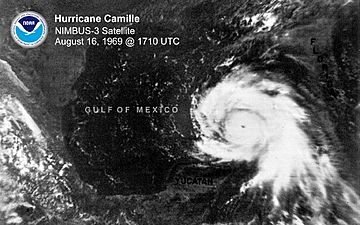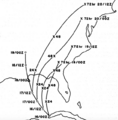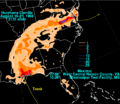Hurricane Camille facts for kids
| Category 2 hurricane (SSHWS/NWS) | |
 |
|
| Formed | August 14, 1969 |
|---|---|
| Dissipated | August 22, 1969 |
| Highest winds | 1-minute sustained: 100 mph (165 km/h) |
| Lowest pressure | 986 mbar (hPa); 29.12 inHg |
| Damage | $1.42 billion (1969 USD) |
| Areas affected | Cuba, Alabama, Mississippi, Louisiana, Southern United States, East-Central United States |
| Part of the 1969 Atlantic hurricane season | |
Hurricane Camille was an incredibly powerful storm. It was the second hurricane of the 1969 Atlantic hurricane season to be given a name. Camille was one of only three hurricanes in the 20th century to reach the highest strength, a Category 5, when it hit the United States. It caused huge damage when it made landfall near the Mississippi River on the night of August 17, 1969.
The storm started forming on August 14 and quickly became much stronger. It brushed past the western side of Cuba as a Category 3 hurricane. Camille then got even stronger over the Gulf of Mexico. When it hit land, its central pressure was very low, at 900 millibars. This meant it had incredibly strong winds, estimated at 200 mph (305 km/h). It also created a massive storm surge of 24 feet (7.3 m).
By its wind speeds, Hurricane Camille was one of the strongest storms ever recorded to hit land anywhere in the world. It was one of only four tropical storms worldwide to ever reach wind speeds of 190 mph. The hurricane flattened almost everything along the coast of Mississippi. It also caused more flooding and deaths further inland as it moved over the Appalachian Mountains in Virginia. In total, Camille sadly killed 259 people. It caused $1.42 billion in damages in 1969, which would be about $9.14 billion today.
Contents
What Was Hurricane Camille?
Hurricane Camille was a very dangerous and powerful storm. It was a type of tropical cyclone that forms over warm ocean waters. Hurricanes are measured on a scale from Category 1 to Category 5. Camille reached Category 5, which is the highest and most destructive level. This means it had incredibly strong winds and could cause extreme damage.
How Hurricanes Are Measured
Hurricanes are measured using the Saffir–Simpson Hurricane Scale. This scale uses the hurricane's wind speed to decide its category.
- Category 1: Winds 74-95 mph (119-153 km/h)
- Category 2: Winds 96-110 mph (154-177 km/h)
- Category 3: Winds 111-129 mph (178-208 km/h)
- Category 4: Winds 130-156 mph (209-251 km/h)
- Category 5: Winds 157 mph (252 km/h) or higher
Camille's winds were estimated at 200 mph, making it a very rare and powerful Category 5 storm.
Camille's Journey
Hurricane Camille began as a tropical storm on August 14, 1969. It quickly gained strength as it moved across the warm waters of the Atlantic Ocean.
Path of the Storm
- August 14: Camille forms and starts to get stronger.
- August 15: It becomes a hurricane.
- August 16: Camille passes near the western part of Cuba as a Category 3 hurricane. It causes some damage there.
- August 17: The hurricane moves into the Gulf of Mexico and gets even stronger, becoming a Category 5 storm. It then makes landfall near the mouth of the Mississippi River.
Landfall and Impact
When Hurricane Camille hit the coast, it brought extreme winds and a huge wall of water called a storm surge.
Devastation on the Coast
The storm surge from Camille was 24 feet high. This is like a two-story building made of water crashing onto the land. The surge, combined with the 200 mph winds, destroyed almost everything along the coast of Mississippi. Homes, businesses, and roads were completely wiped out. Many ships were pushed far inland.
Inland Flooding
After hitting the coast, Camille moved inland. Even though it weakened, it still brought very heavy rain. When it reached the Appalachian Mountains in Virginia, the rain caused severe flash floods. Rivers overflowed their banks, and landslides occurred. This flooding caused more deaths and damage far from the coast.
Human Cost and Damages
Hurricane Camille was a very tragic event.
- Deaths: 259 people lost their lives directly because of the storm.
- Damage Cost: The total damage was estimated at $1.42 billion in 1969. To give you an idea of how much that is today, it would be over $9 billion. This makes Camille one of the most expensive hurricanes in U.S. history.
Images for kids
-
Ships beached in Gulfport, Mississippi.
-
Flooding damage at Howardsville, Virginia; the bridge formerly carried Virginia Route 626 over the Rockfish River.
See also
 In Spanish: Huracán Camille para niños
In Spanish: Huracán Camille para niños












